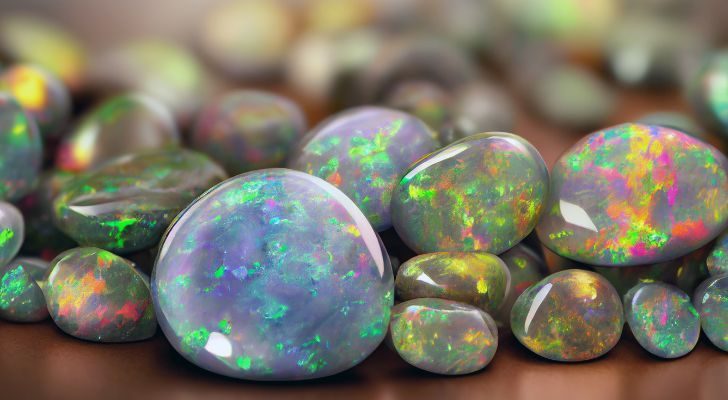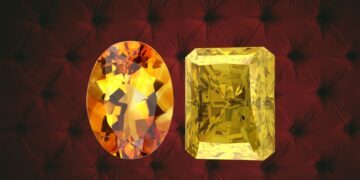In 1812, the National Association of Jewelers (now the Jewelers of America) updated the list of birthstones.
The new list was dubbed the “modern” list, the previous list was renamed the “traditional” list, and birthstones of historical cultures were put on the “ancient” list.
This is how October ended up with two birthstones: tourmaline (“modern”) and opal (“traditional”).
Together, these two remarkable gems are among the most colorful in the world. Just how colorful are they? Read on to find out more about these two stupendously eye-catching gemstones.
Tourmaline is made of boron silicate, or “borosilicate.” During formation, borosilicates can join with a whopping 32 other minerals in various combinations and concentrations. These mineral combinations give tourmaline a wider range of colors than any other gemstone.
Tourmaline can even display two or more colors within a single crystal, one color on one end and a different color on the other, or one color inside and another outside.
Tourmaline is formed when hot mineral-laden water vapor filters into cavities in rock, where it crystallizes. Later, other vapors carrying different minerals enter the same crevice, resulting in layers of diverse colors.
Tourmaline is the only mineral whose natural structure is a column-like three-sided prism.
Tourmaline is mined all over the planet, but California and Maine are the only places in the U.S. where it’s found. Tourmaline is Maine’s state mineral. In California, tourmaline has surpassed every other gemstone in terms of cumulative dollar value.
The complex molecular structure of tourmaline results in a feature where the crystals become electrically charged when heated (“pyroelectric”) or from friction when rubbed (“piezoelectric”). Both result in a negative charge at one end and a positive charge at the other.
When charged, a tourmaline crystal attracts small items such as dust, ashes, pieces of paper, and wood shavings. Amber is another mineral with this property.
This property makes tourmaline handy for scientific devices such as sonar instrumentation and depth gauges.
Unfortunately, tourmaline cannot be manufactured artificially due to its complex structure.
Tourmaline is said to possess many positive qualities, including promoting healing, enhancing spirituality, and providing protection. It is also thought to inspire creativity. It’s claimed that Shakespeare collected tourmaline to help him overcome writer’s block.
It’s said that people in ancient Greece thought opals formed from the tears of Zeus. In reality, opal is formed in underground crevices by the coming and going of silicon-laden water over millions of years.
Silicon is the second most common element in Earth‘s crust, and when water trickles through it, some of the silicon dissolves in it. When this water becomes trapped in cracks underground, the water evaporates, leaving the silicon behind. The silicon hardens into microscopic spheres over time. When this process is repeated over eons, layers of silicon spheres collect, forming opal.
When light hits an opal, it bounces off the curves of the spheres and illuminates the gem in what is called the “play of light.” Different colors are refracted depending on the size of the spheres. For example, silicon balls 0.2 microns wide refract blue and violet light.
Opal isn’t technically a mineral because it lacks a definite crystalline structure. Instead, it’s classified as a “mineraloid” along with amber, pearls, and obsidian. Opals are not sedimentary, igneous, or metamorphic.
Most opals are between 30 million and 160 million years old. It may take 5 million years of repeated wet and dry cycles to form a single half-inch of opal.
Because opals form in the tiniest subterranean crevices, there have been instances where opals formed inside bones, teeth, seashells, snails, and wood. Petrified wood has the identical chemical makeup as opal. Australia is the only place where opal-laced dinosaur fossils have been found.
About 95 percent of the world’s opals come from Australia. The opal fields of Australia are bigger than the opal fields of the rest of the world combined.
There are two places in the U.S. where opals are found: Nevada and Idaho.
Opals have been found on Mars, indicating a long history of water on the planet at some point in the past.
Some people feel that opals aid in emotional healing while enhancing intuition and bringing a sense of calm and inner peace.

Every gemstone has its own story of how it originated over eons deep within the Earth. Tourmaline and opal have unique chronicles, not only of how they formed but also of their history with humanity.
Because tourmaline is available in nearly every color of the rainbow, and opal often has every color within a single stone, these two birthstones are unparalleled among all others.
This means those born in October are lucky to have whatever color they want from each of their two incredibly interesting and colorful birthstones!


















